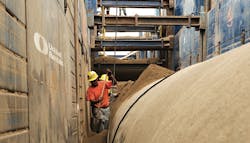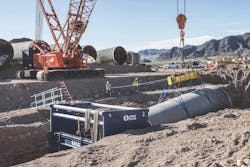Osha Trench Safety Toolbox Talk Promotes Safe Work Practices
Richard Overman is region product development manager for United Rentals Trench Safety.
undefinedTrench and excavation operations are among the most dangerous jobs, presenting daily worksite challenges in construction applications, including water and wastewater infrastructure.
A cubic yard of soil weighs as much as a car, so a trench collapse can kill a worker in minutes. According to U.S. Bureau of Labor Statistics data 130 fatalities occurred in trenching and excavation operations between 2011 and 2016.
Everyone working at these sites must be knowledgeable about hazards of working in trenches and trench safety practices, including excavation standards, such as the 29 CFR 1926, Subpart P-Excavation Standard. Toolbox talks—informal, topic-specific, short-format meetings—provide an excellent opportunity for municipal and industrial organizations to advance worker knowledge about trench hazards and safe work practices in trenching and excavation operations.
Here are seven toolbox talk topics that all construction organizations, including water and wastewater professionals, should consider to reinforce trench safety basics to jobsite workers and promote a safety culture.
1. OSHA 12 Specific Requirements
Review the 12 specific requirements related to excavations specified by the Occupational Safety and Health Administration (OSHA 1926.651 General Requirements). Discuss these requirements, which address areas such as access and egress, exposure to vehicular traffic, warning systems and more, to promote greater awareness. Create a “Trenching & Excavating by the Numbers” exercise to build worker retention of excavation standards, such as five—the number of feet at which a protective system becomes mandatory—and 25—the maximum distance in feet a worker may travel to reach a means of egress.
2. Soil Classification
Soils are among the most important factors to consider when following the required manual and visual tests to identify the correct protective system solution. The soil type dictates the trench protective system that can be used, including sloping, bench, shielding or shoring. Remind workers that soil needs to be reevaluated anytime site conditions change.
3. Protective Systems – Sloping & Benching
Sloping and benching protect workers from cave-ins by cutting back trench walls. With sloping, the wall is cut at an angle inclined away from the excavation. Benching involves excavating the sides of an excavation to form one or a series of horizontal levels or steps. A toolbox talk can review common mistakes associated with benching, such as benching in Type C soil—which OSHA does not allow—and benching in granular soil. OSHA allows benching in cohesive soil only and never allows benching in granular soil.
4. Protective Systems – Shoring
Shoring is an active system designed to prevent cave-ins by applying positive pressure against trench walls. Conduct a hands-on talk with a hydraulic vertical shore, reviewing available sizes, limitations, installation instructions and proper usage. Remind workers it is essential positive shoring be placed correctly, according to the manufacturer’s tabulated data.
5. Protective systems – Shielding & Trench Boxes
These are passive systems. They do not prevent cave-ins like shoring does. They are designed to withstand a cave-in and protect workers, provided the shield is properly installed. Review shielding options available, including aluminum boxes and steel boxes. Perform an inspection on a shield to show how to check that all components are present and intact.
6. Tabulated Data
Review different types of tabulated data that come with all manufactured shielding and shoring equipment. This data details proper equipment use and limitations, covering areas such as assembly instructions, soil types and maximum depth rating. Remind workers this information must always be onsite, either on paper or electronically. If the scope of work is outside what the equipment is rated for per the tabulated data, another protective system needs to be considered or an engineer needs to get involved to create a site-specific plan.
7. Site-Specific Engineering
Excavations near adjacent structures, underground utilities and roadways may come with unique and complex challenges that require professional input. Although contractors can usually utilize manufactured systems with tabulated data, there are times where additional guidance and stamped drawings from a professional engineer are necessary. A toolbox activity can include reviewing when to call upon a professional engineer, which include when heavy surcharges—such as heavy equipment, stockpiled equipment, roads, bridges and buildings—are close to the excavation.
Maintaining up-to-date training on safety regulations and equipment solutions is indispensable to help keep workers safe and productive. Conducting meaningful toolbox talks to review these fundamental principles with all employees will ensure that everyone has a good foundation of understanding the basics of trench safety.
Editor’s Note: This article is for informational purposes only and generally discusses common industry processes and procedures. The article is not intended to be a substitute for site-specific professional/expert advice, instruction and supervision. United Rentals recommends consulting with Shoring and Excavation Experts to ensure full compliance with Federal OSHA 29 CFR, Part 1926, Subpart P-Excavations and Trenches, and any other applicable rules and regulations.
Read related articles on Safety & Security:

